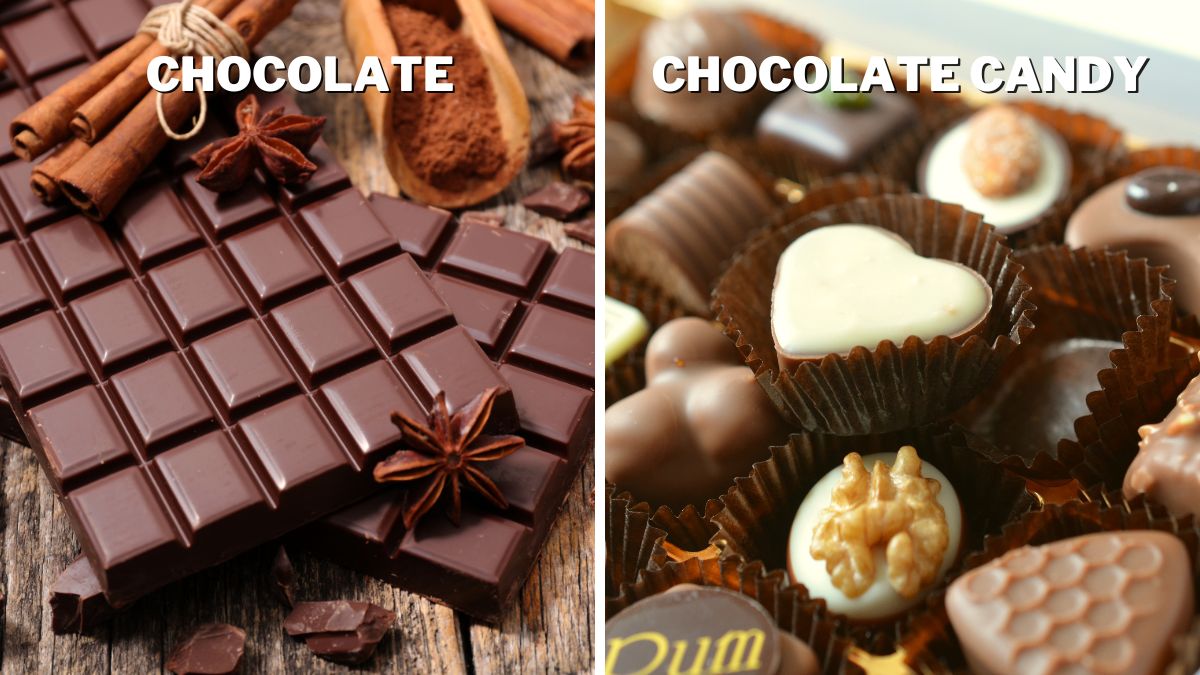Is Chocolate a Candy? Find Out the Differences Here!

You can rarely hear that someone doesn’t like sweets, especially chocolate. This divine product is part of almost every culture around the world, and for some, it is even the main product for massive commercial export. While you enjoy its sweet taste, it may cross your mind “is chocolate a candy?”
Whether you are a big fan of one of them, or you just can’t make up your mind which is better for you, keep reading. You will learn what exactly separates chocolate from candy and why some people still consider it candy!
How Is Chocolate Different from Candy?
Chocolate is not candy on the first sight. It is an edible product made of ground-roasted cocoa beans. However, State Department of Revenue classifies it as candy because it doesn’t have flour.
Still, chocolate and candy taste differently. Cocoa beans are very bitter until you mix them with sugar that makes chocolate sweet in taste. On the other hand, the base of candy is sugar. Of course, you can find candies with artificial sweeteners, but the key is that the base is sweet.
Chocolate and candy differ in nutritional value. If you are eating candy, you are consuming what is called empty calories. On the other hand, chocolate has some benefits for your well-being! [1]
Before diving into the nutritional details, please review our Nutritional Disclaimer page for important context and clarifications.
While they are not generally marketed as candy, some types of sweetened chocolate that are formed into bars for cooking use could be considered candy. It is also interesting that some people call chocolate candy “chocolate,” but candy without chocolate is only ”candy” for them.

Which Is Better: Chocolate or Candy?
Choosing between a bar of chocolate and a few pieces of candy can be very difficult since they are both great treats for every sweet tooth.
The good thing about candies is that, usually, they are smaller in size, so you can easily try different types. In contrast, the serving size of chocolate is bigger. So, when you open a bar of chocolate, you eat a sweet bar that has the same taste all the time. But, also, it means that you eat it longer. I would say that that’s an advantage!
Furthermore, many different companies produce chocolate and candies, and all of them have different recipes. This means that there are thousands of different chocolates on the market, and even more types of candies.
If one person adores chocolate, it doesn’t mean that he or she would like every type of it. The same goes for candy.
Chocolate and candy have different nutritional values. Note that people who consume sweets on a regular basis do not get proper nutrition or energy from candy.
According to USDA, candies have minimal nutritional value. [2] They lack nutrients such as vitamins, minerals and protein, and are in the same group as chewing gums and soda water.
On the other hand, chocolate has some nutritional benefits, especially the ones with a high percentage of cacao solids. When you eat one bar of dark chocolate, you consume 72% of iron daily needs, 59% of magnesium needs, and 9% of calcium needs. [3] Pretty awesome, right?
Both of them give us a lot of energy. It means that they are rich in calories and are often to blame for gaining weight. Thus, make sure you measure serving sizes carefully.
To summarize this part, it depends on each person individually which is tastier, but data says chocolate is healthier.
What Is Candy?
Candies can come in different forms, sizes and tastes. Depending on the ingredients and the temperatures at which candy is processed, candy has a different texture. Candy is usually divided into smaller portions, unlike the cakes or pies that many people share. Still, this doesn’t mean that the cupcakes are candy since their production is more similar to the cakes’. Cupcakes are, indeed, the small cakes.
Candy is a mixture of natural or artificial sweeteners and chocolate, fruit, nuts or other ingredients and flavors.
There are two types of sugar candies: noncrystalline and crystalline. [4] Generally, noncrystalline candies are homogeneous and may be chewy. Examples include hard candies, caramel, toffee, and nougats.
Crystalline candies include fondant and fudge, both of which have crystals within their structure and are so creamy that they easily melt on your tongue. Examples of fondant candies are soft mints, marshmallows and cotton candy.
A distinct segment of sweets is often dedicated to chocolate. This category features treats like chocolate bars and chocolate truffles.
What Is Not Considered Candy?
Candy preparation does not include adding flour and refrigeration. This is the key point that differentiates candy from cookies.
Licorice contains flour and, for that reason, some people say that it is not candy.
By now, you already know that it’s not that simple to answer if every chocolate is candy or not. If we were to listen to the State Department of Revenue, most chocolates are candy because they don’t have flour listed on the list of ingredients. [5]
At the same time, chocolate bars like Kit Kat are not considered candies because they have wafers inside, which means they have flour.
Chocolate- and cocoa-based drinks, as well as sweets made from white chocolate, are also excluded.
In terms of chocolate as a specific branch, it also includes confections whose classification is otherwise problematic—for example, chocolate-covered things, chocolate-coated cookies and chocolate-dipped foods.
To conclude, chocolate can be considered candy, but its nutritional value is greatly different from other candies, so don’t bother if it is or not candy. Just enjoy its delicious taste!
